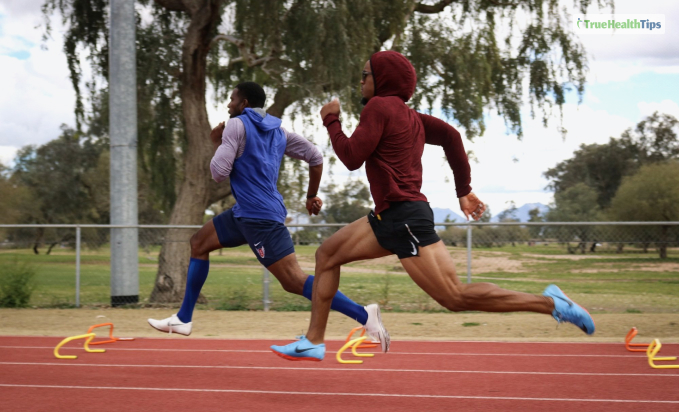
Sprint workouts make you think of Usain Bolt? Ding! Ding! Ding! Well, it is related to that superstar of an athlete. Sprinting is a professional sport where an athlete runs at their top speed in a short amount of time. It makes them run at top speed. Sprint workouts make sure the sprinters can keep improving their speed. Helping them beat their records.
If you are a sprinter doing some light reading in between your training, this article introduces the logic behind doing sprint workouts. While also suggesting which ones you can do to get your performance at its best.
Why Sprint Workouts?
Do you think of the time you were asked to run track in your school? Like so many of us, do you also get that dreadful feeling inside you? Well, then, I must shift your focus towards the feeling you would get post-run. You can hear your heartbeat in your ears, almost as if you are feeling every pulse within your chest.
The sprint workouts have a lot of benefits. The following are a few:
Health Benefits of Sprint Workouts:

1. Cardiovascular Health: The primary mechanism on which sprinting runs (see what I did there? 😉) is completing the activity in as short a time as possible. This may sound similar to HIIT or High Intensity Interval Training. HIIT, an evergreen favorite in the fitness industry, is every trainer’s or fitness enthusiast’s go-to workout to get that adrenaline rush for heart health. Cardiovascular health is essential to our fitness, ensuring overall health is at or above par. The blogs and fitness sites suggesting different exercises for our health and well-being will have at least one activity that boosts your cardiovascular health.
All good sprint workouts will give you the cardiovascular boost needed to get your heart working just fine.
2. Metabolic Impact: The metabolic impact of a workout is known as the overall effect of an exercise on the physiology of our body. High-intensity exercises such as sprinting can keep your metabolism active even after the sprint. If you have received personal training, you would know that weight lifting keeps your calories burning even after you are done with the workout. Similarly, sprint workouts burn more calories than jogging.
The current evidence suggests the positive effect sprinting has on the metabolism. Sprinting overcomes the natural reluctance of modifying muscle fibers to fast-twitch. Make sure that even after you finish the exercise, you can increase the overall amount of calories that are burnt post-workout.
Time Efficiency
Sprinting on its own is a great workout that is time efficient. As the articles mentioned above, it is a form of HIIT that implies that the training you do in a short time gives you better results than long-period exercises, which was previously contradicted- until there was research to prove it true.
Compared to traditional cardio workouts that are usually added to an athlete’s training, sprinting is a better workout due to its high-intensity nature. Moreover, conventional cardio workouts need time to show results. Sprinting is known to help burn abdominal fat better than jogging and improve your aerobic power.
Getting Started with Sprint Workouts

Preparing for Sprinting
1. Importance of Warm-up: Warm-up is an integral part of any exercise or workout routine. Warm-ups are essential to get your body in the “ready for action” state. Warm-ups can include light stretches, as well as light cardio, such as jogging to expend your energy. Warm-ups also help the joints, muscles, and mind prepare for the workout.
Take a few notes from the following video:
2. Proper Attire and Footwear: It is no secret that working out requires proper clothing, especially shoes, that can boost your movement rather than hinder it. Wearing proper attire, such as sweat-absorbing fabric, will help you stay cool and not get irritated while running your track. Similarly, proper attire during your sprint workout is necessary to ensure you freely do your workouts.
Additionally, the proper shoes for your sprinting workout can help you ensure that you are preventing injuries. Proper shoes that are a good fit and serve the purpose- for example, you would need good running shoes here. A good pair of running shoes will provide the needed support while decreasing the risk of injury to your ankle and feet.
Choosing the Right Location
Track vs. Outdoor Spaces:
A flat surface like the track is the most popular spot for sprinting workouts. Tracks are built to ensure you have a hindrance-free area for your uninterrupted workout. On the contrary, other outdoor spaces include hiking trails, parks, and large fields. They can lead to injuries from either small stones or undulated surfaces. Track sprint workouts need your attention as they help you effectively prepare yourself for track sprinting.
Top 3 Types of Sprint Workouts
A. Short Sprints

1. 30-Second Sprints: Part of a beginner’s routine, this is a fairly simple yet effective sprint workout. 30-second sprints are part of wind sprint workouts that help push your body to its limits. 30-second sprints help increase the heart rate and stimulate metabolism. This helps improve the calories your body burns during and after sprint workouts.
2. Tabata Intervals: Tabata intervals are a type of training that breaks down the workout into clear intervals. You can use this technique to do your 30-second push-it-to-the-limit sprinting and follow it up with a short, 10-second break. This technique helps you jump your heart rate up quite quickly.
B. Medium-Length Sprints

1. 200-Meter Sprints: In this workout, you learn how to accelerate around the line and the turn.
- The workout is best done when you are at a 5K pace.
- This allows you to ride out the sprint at a steady pace.
- The resting time for this exercise is 60 seconds, and if you increase it to 120 seconds or 2 minutes, you need to pick up the pace to work down your goal mile.
- The workout has aerobic effort but provides cardio fitness.
Here are three tips to improve your 200m sprint workouts for the track:
2. Pyramid Sprints: This concept includes going up and down a pyramid that starts at a hard interval for one minute, taking it up to five minutes. Then you work your way down back to one minute. The following video should be helpful in understanding:
C. Long Sprints

1. 400-Meter Sprints: This is an advanced version of the first one, which includes progressing to the advanced version of sprint workouts.
- The pace you start at is 10K while gradually working down.
2. Fartlek Training: This technique helps nail this workout as it involves random variations in intensity and speed. You are required to alternate between slower recovery jogging and bursts of sprinting. Overcoming Challenges
A. Dealing with Muscle Fatigue: The best way to decrease your fatigue chances is by avoiding excess of anything. Do not do excessive dynamic stretching, as it will affect your performance. Do not overdo it; it can lead to tiredness rather than feeling energized.
B. Gradual Progression and Avoiding Overtraining: This strategy can help you overcome the challenges. You should do it carefully when you gradually progress through the workout, going up or down the pace. Doing it too quickly will result in fatigue and increase the chances of injuries.
Pro tip:
- Start the workouts with 50% effort to reach up to 80% and then 100% by the end of the workout.
Avoiding overtraining is another factor you must consider when considering overcoming challenges. You must complete whatever set of repetitions are left for you instead of going ahead and trying to overdo it in one go.
Another great way to overcome the challenges is to make the workout enjoyable. You can do this by adding a few variations. In addition, experts also recommend building confidence with the help of setting up smaller milestones that are achievable. An example of this is- beginning the journey by ensuring you practice your sprint workouts at least 15-30 minutes a day or thrice a week.
Conclusion
This was all on the top three sprint workouts you can add to your regime. The three workouts listed in the article are good sprint workouts. So, if your goal is to build your workout plan, you’ll find this article useful.
Let us know in the comments below if there is a workout we should have added to our top 3!
Read Also:











